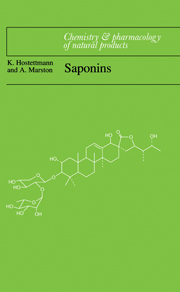Book contents
- Frontmatter
- Contents
- Glossary
- 1 Introduction
- 2 Occurrence and distribution
- 3 Analysis and isolation
- 4 Structure determination
- 5 Triterpene saponins – pharmacological and biological properties
- 6 Steroid saponins and steroid alkaloid saponins: pharmacological and biological properties
- 7 Commercially important preparations and products
- Appendices
- References
- Index of Latin names
- General index
1 - Introduction
Published online by Cambridge University Press: 19 October 2009
- Frontmatter
- Contents
- Glossary
- 1 Introduction
- 2 Occurrence and distribution
- 3 Analysis and isolation
- 4 Structure determination
- 5 Triterpene saponins – pharmacological and biological properties
- 6 Steroid saponins and steroid alkaloid saponins: pharmacological and biological properties
- 7 Commercially important preparations and products
- Appendices
- References
- Index of Latin names
- General index
Summary
General introduction
Saponins are high-molecular-weight glycosides, consisting of a sugar moiety linked to a triterpene or steroid aglycone. The classical definition of saponins is based on their surface activity; many saponins have detergent properties, give stable foams in water, show haemolytic activity, have a bitter taste and are toxic to fish (piscicidal). Such attributes, while not common to all saponins, have frequently been used to characterize this class of natural products. However, because of the numerous exceptions which exist, saponins are now more conveniently defined on the basis of their molecular structure, namely as triterpene or steroid glycosides.
Some saponin-containing plants have been employed for hundreds of years as soaps and this fact is reflected in their common names: soapwort (Saponaria officinalis), soaproot (Chlorogalum pomeridianum), soapbark (Quillaja saponaria), soapberry (Sapindus saponaria), soapnut (Sapindus mukurossi). Indeed, the name ‘saponin’ comes from the Latin word sapo (soap).
Saponins are constituents of many plant drugs and folk medicines, especially from the Orient. Consequently, great interesthas been shown in their characterization and in the investigation of their pharmacological and biological properties.
Since the appearance of Kofler's book Die Saponinein 1927, the field has undergone a most remarkable transformation. Kofler described in great detail the properties and pharmacological activities of saponins but at that time nota single saponin had been fully characterized. In contrast, by 1987 the structure of over 360 sapogenins and 750 triterpene glycosides had been elucidated (Bader and Hiller, 1987).
- Type
- Chapter
- Information
- Saponins , pp. 1 - 17Publisher: Cambridge University PressPrint publication year: 1995
- 6
- Cited by

